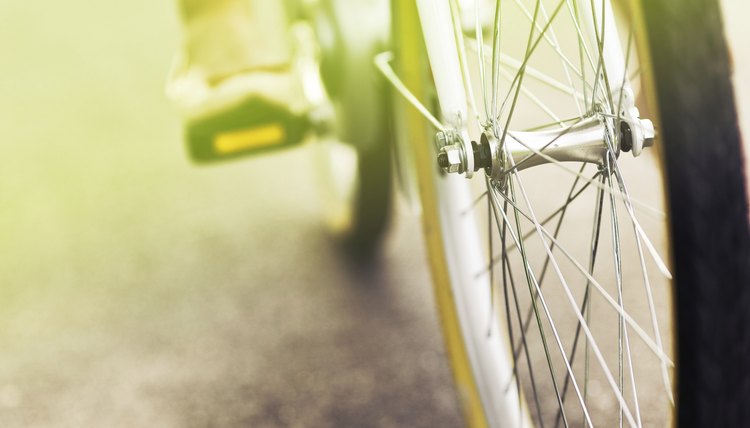How to Clean Aluminum Bicycle Wheels

Cleaning your aluminum wheels is an important habit to get into if you ride often. The build-up of road grime, dust and salt from riding in adverse conditions can make braking less consistent and wear down your rims faster. As particles of sand and grit get stuck under your brake pads, the act of braking can wear grooves into the sidewalls of your rim, decreasing their life and reducing stopping power. You can clean your rim with a number of different cleaning products, but something biodegradable and non-corrosive is ideal for your rims and spokes. Once you have your wheels cleaned up, a quick check of your brake pads should stop any squealing or chattering during braking.
Remove both wheels from the bike using the quick releases. You want to be able to get to every surface of the wheel; having them attached to the bike can make this difficult. Make sure to disconnect the brakes before attempting to slide the wheel out of your drop-outs.
Give the wheels a once-over with a damp rag. You don't want to scrub any sand or dirt against the rim, so removing most of the dirt using a rag is a good way to get the rim ready for cleaning. Don't worry about being too thorough; just try and remove any visible dirt.
Scrub the braking surface of the rim gently with the steel wool or scrubbing pad soaked in citrus degreaser. Work your way around the rim, scrubbing "with the grain" in a lateral direction that is in line with the path your rim brakes follow. Scrub both sides of the rim on each wheel, rinsing the steel wool or scrubbing pad occasionally and refreshing the citrus degreaser.
Clean each spoke and spoke nipple individually with citrus degreaser. You can use the scrubbing pad or the rag; since the spokes are smooth, they should be relatively easy to clean.
With a separate scrubbing pad, wipe down the braking surface thoroughly with rubbing alcohol to remove all of the citrus degreaser. Clean the sidewalls of the tire as well; you don't want any degreaser left on the rim that might impede braking. The rubbing alcohol will evaporate and doesn't need to be rinsed off.
Using the fine grit sandpaper, gently abrade the brake pads to remove any buildup of rubber dust or dirt. Then, place the wheels back on the bike and reattach the brakes, checking that the pads are properly toed in. You can adjust the tilt of the brakes using the Allen wrench set. Make sure your brakes are parallel with the rim and aren't touching the tires and that they touch down on the side pointing towards the front of the bike first.
Tips
If you've never adjusted brakes before, it's a good idea to let a shop do it. Brake adjustments are a precise process that can result in squealing or ineffective braking if done incorrectly.
Warnings
Never apply grease to your aluminum rims. It can result in an inability to brake, which is extremely dangerous.
References
Resources
Tips
- If you've never adjusted brakes before, it's a good idea to let a shop do it. Brake adjustments are a precise process that can result in squealing or ineffective braking if done incorrectly.
Writer Bio
Max Roman Dilthey is a science, health and culture writer currently pursuing a master's of sustainability science. Based in Massachusetts, he blogs about cycling at MaxTheCyclist.com.
